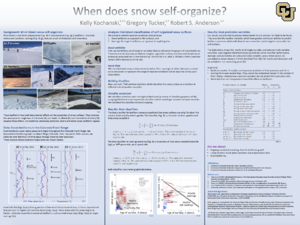2018 CSDMS meeting-069: Difference between revisions
(Created page with "{{CSDMS meeting personal information template-2018 |CSDMS meeting first name=Kelly |CSDMS meeting last name=Kochanski |CSDMS meeting institute= |CSDMS meeting city= |CSDMS mee...") |
No edit summary |
||
| (2 intermediate revisions by 2 users not shown) | |||
| Line 2: | Line 2: | ||
|CSDMS meeting first name=Kelly | |CSDMS meeting first name=Kelly | ||
|CSDMS meeting last name=Kochanski | |CSDMS meeting last name=Kochanski | ||
|CSDMS meeting institute= | |CSDMS meeting institute=University of Colorado - Boulder | ||
|CSDMS meeting city= | |CSDMS meeting city=Boulder CO | ||
|CSDMS meeting country= | |CSDMS meeting country=United States | ||
|CSDMS meeting state= | |CSDMS meeting state=Colorado | ||
|CSDMS meeting email address=Kelly.Kochanski@Colorado.EDU | |CSDMS meeting email address=Kelly.Kochanski@Colorado.EDU | ||
|CSDMS meeting phone= | |CSDMS meeting phone=4125196062 | ||
}} | }} | ||
{{CSDMS meeting scholar and pre-meeting | {{CSDMS meeting scholar and pre-meeting | ||
|CSDMS meeting pre-conference= | |CSDMS meeting pre-conference=Bootcamp | ||
|CSDMS meeting post-conference=No | |CSDMS meeting post-conference=No | ||
}} | }} | ||
{{CSDMS meeting select clinics1 2018 | {{CSDMS meeting select clinics1 2018 | ||
|CSDMS_meeting_select_clinics1_2018= | |CSDMS_meeting_select_clinics1_2018=1) Google Earth Engine | ||
}} | }} | ||
{{CSDMS meeting select clinics2 2018 | {{CSDMS meeting select clinics2 2018 | ||
|CSDMS_meeting_select_clinics2_2018= | |CSDMS_meeting_select_clinics2_2018=1) Structure from Motion (SfM) | ||
}} | }} | ||
{{CSDMS meeting select clinics3 2018 | {{CSDMS meeting select clinics3 2018 | ||
|CSDMS_meeting_select_clinics3_2018= | |CSDMS_meeting_select_clinics3_2018=4) Artificial Intelligence & Machine Learning | ||
}} | }} | ||
{{CSDMS scholarships yes no | {{CSDMS scholarships yes no | ||
|CSDMS meeting scholarships= | |CSDMS meeting scholarships=Yes | ||
}} | }} | ||
{{CSDMS meeting abstract yes no 2018 | {{CSDMS meeting abstract yes no 2018 | ||
|CSDMS meeting abstract submit= | |CSDMS meeting abstract submit=Yes | ||
}} | |||
{{CSDMS meeting abstract title temp2018 | |||
|CSDMS meeting abstract title=Statistical classification of self-organized snow surfaces | |||
}} | |||
{{CSDMS meeting authors template | |||
|CSDMS meeting coauthor first name abstract=Greg | |||
|CSDMS meeting coauthor last name abstract=Tucker | |||
|CSDMS meeting coauthor institute / Organization=CU, Boulder | |||
|CSDMS meeting coauthor town-city=Boulder | |||
|CSDMS meeting coauthor country=United States | |||
|State=Colorado | |||
}} | |||
{{CSDMS meeting authors template | |||
|CSDMS meeting coauthor first name abstract=Bob | |||
|CSDMS meeting coauthor last name abstract=Anderson | |||
|CSDMS meeting coauthor institute / Organization=CU, Boulder | |||
|CSDMS meeting coauthor town-city=Boulder | |||
|CSDMS meeting coauthor country=United States | |||
|State=Colorado | |||
}} | |||
{{CSDMS meeting abstract template 2018 | |||
|CSDMS meeting abstract=Wind-swept snow self-organizes into bedforms. These bedforms affect local and global energy fluxes, but have not been incorporated into Earth system models because the conditions governing their development are not well understood. We created statistical classifiers, drawn from 736 hours of time-lapse footage in the Colorado Front Range, that predict bedform presence as a function of windspeed and time since snowfall. These classifiers provide the first quantitative predictions of bedform and sastrugi presence in varying weather conditions.<br>The flat snow surfaces we saw were all short-lived. The probability that a surface remained flat, rather than bedform-covered, decreased with time and with the average shear stress exerted on the surface by the wind.<br>The most persistent snow features were an erosional bedform known as sastrugi. The likelihood that a surface was covered by sastrugi increased with time and with the highest wind speeds experienced by the surface.<br>These results identify the weather variables which have the strongest effect on snow surfaces. We expect that these variables will inform and feature in future process-based models of bedform growth. Our observations therefore represent a first step towards understanding a self-organized process that ornaments 8% of the surface of the Earth. | |||
|CSDMS meeting posterPDF=Kochanski_CSDMS_POSTER_May2018.pdf | |||
|CSDMS meeting posterPNG=Kochanski_CSDMS_POSTER_May2018.png | |||
}} | }} | ||
{{blank line template}} | {{blank line template}} | ||
Latest revision as of 19:43, 25 May 2018
Log in (or create account for non-CSDMS members)
Forgot username? Search or email:CSDMSweb@colorado.edu
Browse abstracts
Statistical classification of self-organized snow surfaces
Wind-swept snow self-organizes into bedforms. These bedforms affect local and global energy fluxes, but have not been incorporated into Earth system models because the conditions governing their development are not well understood. We created statistical classifiers, drawn from 736 hours of time-lapse footage in the Colorado Front Range, that predict bedform presence as a function of windspeed and time since snowfall. These classifiers provide the first quantitative predictions of bedform and sastrugi presence in varying weather conditions.
The flat snow surfaces we saw were all short-lived. The probability that a surface remained flat, rather than bedform-covered, decreased with time and with the average shear stress exerted on the surface by the wind.
The most persistent snow features were an erosional bedform known as sastrugi. The likelihood that a surface was covered by sastrugi increased with time and with the highest wind speeds experienced by the surface.
These results identify the weather variables which have the strongest effect on snow surfaces. We expect that these variables will inform and feature in future process-based models of bedform growth. Our observations therefore represent a first step towards understanding a self-organized process that ornaments 8% of the surface of the Earth.

